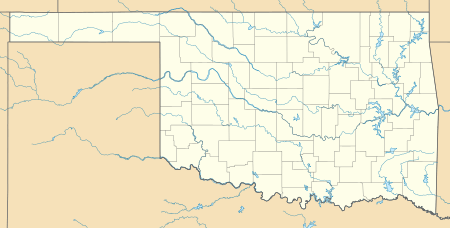Museum of the Great Plains
The Museum of the Great Plains is a children's museum located in Lawton, Oklahoma, USA. The museum’s major exhibits reveal the diverse cultures inhabiting the Great Plains region beginning with the arrival of the Paleo-Indians known as the Clovis culture at approximately 11,500 BCE. A variety of educational programs are offered year around. The museum is one of five partner museums in the Oklahoma Museum Network.
.jpg) Southwest Oklahoma Great Plains Museum | |
 Location within Oklahoma | |
| Location | Lawton, Oklahoma |
|---|---|
| Coordinates | 34°37′05″N 98°23′53″W |
| Type | Natural history museum |
| Accreditation | American Alliance of Museums |
| Founder | Comanche County Historical Society |
| Curator | McMahon Foundation |
| Owner | City of Lawton |
| Website | discovermgp |
Mission
The Museum of the Great Plains is dedicated to the collection, preservation, research, interpretation and exhibition of items pertaining to the cultural and natural history of the Great Plains region of North America in effort to increase knowledge and understanding of humankind.
History
The museum evolved out of the Comanche County Historical Society (CCHS), which was formed in 1952. After a few years of exhibiting its growing collections in a building on Fort Sill, the CCHS began the planning and construction of a new permanent facility. With support from the local McMahon Foundation, the new facility opened in 1961 as the Museum of the Great Plains. The museum is an 18,000-square-foot (1,700 m2) building located in Elmer Thomas Park and managed under the City of Lawton. In 1972, the museum became the first in Oklahoma to receive accreditation from the American Alliance of Museums. In 1997, again with support from the local McMahon Foundation, the museum expanded to 25,000 square feet (2,300 m2) of gallery space, a foyer and a museum gift shop. The original building space was converted into much-needed collections and archival storage, a library and research area, offices and a classroom.
The Institute of the Great Plains (which also originated from the Comanche County Historical Society) and the City of Lawton jointly operated the museum until January 1998, when the museum was reorganized and established as a public trust under the laws of Oklahoma. The institute remained in the building as a tenant and has continued its research, education, and publishing functions to aid the museum in its programs. The Museum of the Great Plains Trust Authority has become the governing board of the museum and received 501(3)-c status as an independent non-profit entity in 1999.
Interpretive philosophy, scope and themes
The museum's educational goals are to:
- Cultivate an appreciation for history in general as well as the particular history of the Great Plains region,
- Encourage meaningful inquiry and investigation of history,
- Reveal personal connections with broader histories that include community, society, country, and world,
- Promote a new awareness and understanding of current day events and our place and relevance and
- Educate visitors about diverse perspectives on the history of the Great Plains.
The museum believes that successful educational programs are experiential in nature, innovative in their presentation, relevant to people's lives, reflective of multicultural perspectives and respectful of different learning styles and abilities.
The chronological scope of the museum's interpretation is broad, covering a time period that begins with the arrival of the first humans on the Great Plains region at approximately 11,500 BCE, up to the present day. Themes include prehistory on the plains, understanding the land, hunters and horsemen, traders and trappers, builders (settlement on the Great Plains), plains warriors, and farmers and ranchers.
Exhibits
Major exhibits are located in the permanent gallery, a temporary gallery, and on the mezzanine.
The 1902 Elgin Depot was moved to the museum's compound in 1962, and a 1926 Baldwin Locomotive is located in front of the Depot.
References
Halliburton, R. "Museum of the Great Plains." Agricultural History 35, no. 3 (1961): 159-61. http://www.jstor.org/stable/3740628.